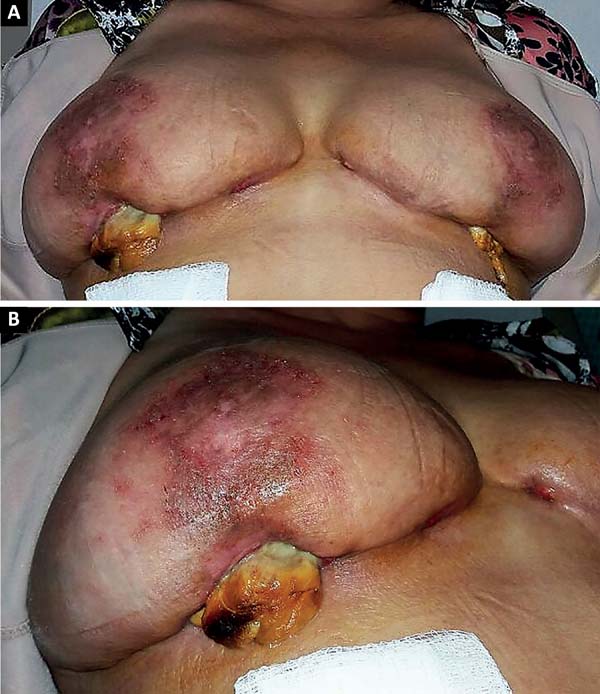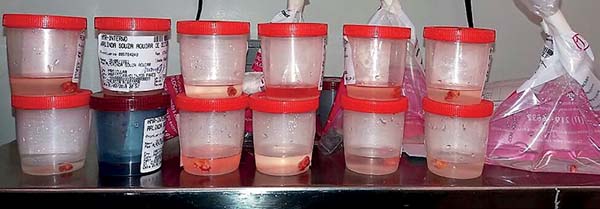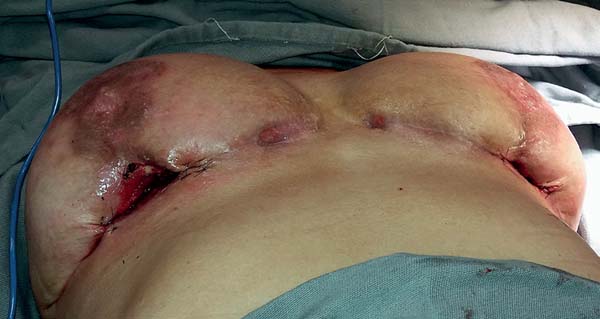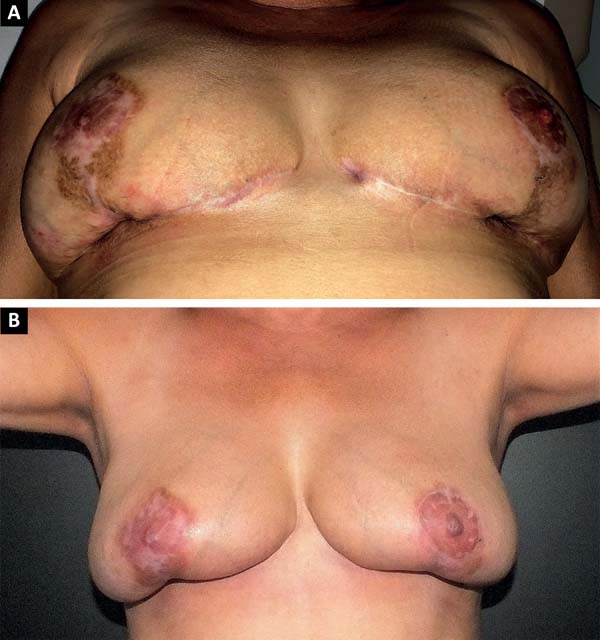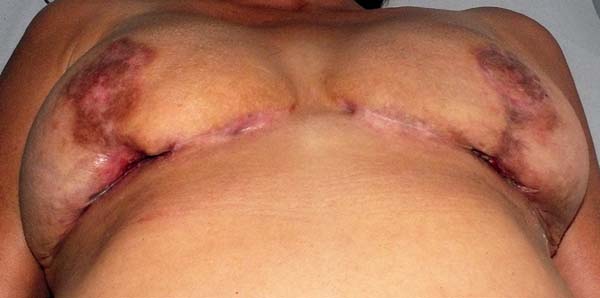INTRODUCTION
Pyoderma gangrenosum (PG) is a neutrophilic inflammatory dermatosis of unknown
etiology, which mainly affects adults aged between 20 and 50 years, and was
described in 1930 by Brusting et al.1 PG
is idiopathic in 25%-50% of cases. In approximately 50% of cases, its
association with systemic diseases, such as Crohn’s disease, monoclonal
gammopathies, seropositive arthritis, collagenosis, Behcet’s disease, Wegener’s
granulomatosis, myeloproliferative and infectious diseases, mainly hepatitis and
AIDS1-4, has been described.
Some patients with PG present altered cellular and humoral immunity with
increased expression of interleukins, especially IL-8 and tumor necrosis factor.
Clinically, it presents four variants: ulcerated, bullous, vegetative, and
pustular. The most prevalent form is the ulcerative type, which begins as a
papule or nodule and rapidly evolves into ulcerated and painful lesions4,5.
In up to 25% of PG cases, the appearance of new lesions can be triggered by
traumas, such as insect bites, intravenous injections, and biopsy, a phenomenon
known as pathergy6.
In this report, we present a case of extensive PG in the breasts in the
postoperative period of reductive mammoplasty, which was difficult to diagnose,
but showed excellent response to corticotherapy (intra and perilesional
corticotherapy with triamcinolone) during debridement and oral steroid therapy
(prednisone) in the weaning phase.
METHODS
This is a case report of a 56-year-old female, who underwent reductive
mammoplasty in another facility for esthetic reasons. Postoperatively, vesicles
appeared around the surgical scars that subsequently ruptured and led to the
emergence of hyperemic areas with ulceration. The wounds further progressed to
areas of necrosis with exposure of breast tissue and purulent secretion. The
surgical wound was bilaterally involved, and progressed beyond the borders of
the surgical wound.
The patient was treated with oral antibiotic therapy by the attending physician
present at that time. After three months of treatment with different antibiotic
regimens, but no satisfactory results, and worsening of the overall condition,
the patient sought our service (Figure 1A
and 1B).
Figure 1 - A: Case report: Progressive worsening despite
multiple antibiotic regimens at postoperative three months of
reductive mammoplasty (Note the appearance of the incision edges and
exuberant pattern of the pyoderma gangrenosum ulcerative form);
B: Enlarged detailed aspect of the right breast at
the beginning of the case, three months after reductive mammoplasty
and multiple antibiotic regimens
Figure 1 - A: Case report: Progressive worsening despite
multiple antibiotic regimens at postoperative three months of
reductive mammoplasty (Note the appearance of the incision edges and
exuberant pattern of the pyoderma gangrenosum ulcerative form);
B: Enlarged detailed aspect of the right breast at
the beginning of the case, three months after reductive mammoplasty
and multiple antibiotic regimens
After a multidisciplinary discussion involving a dermatologist and an
infectologist, debridement was initially proposed in a hospital environment with
collection of multiple fragments of the breast tissue for diagnosis. Twelve
fragments of tissues were collected in total (six fragments from each breast).
Of the six fragments of each breast, we sent four fragments for culture and
antibiogram and two for anatomopathological analysis.
At the end of the debridement and collection of the materials for the study, an
empirical injection of 5 mL triamcinolone (20 mg/mL; diluted in 20 mL of SF
0.9%, totaling a solution of 25 mL) peri and intralesional, was divided for
multiple applications to both breasts. As advised by the infectiologist, the
antibiotic treatment was started orally in an empirical scheme immediately after
debridement, until culture and pathology analyses were available to guide
further (Figure 2).
Figure 2 - Twelve anatomical fragments collected (six each from right and
left breast); four samples sent for cultures and antibiogram and two
sent for anatomopathological analysis
Figure 2 - Twelve anatomical fragments collected (six each from right and
left breast); four samples sent for cultures and antibiogram and two
sent for anatomopathological analysis
Suture closure was not performed; however, containment sutures were placed at the
margins of the cavity (Figure 3). The
debridement was also limited to the devitalized tissues, to avoid any further
tissue damage.
Figure 3 - Debridement and collection of pieces for peri and intralesional
infiltration of triamcinolone; in the area of suspected PG, the
infiltration of peri and intralesional triamcinolone has been
programmed prior to the act of debridement (Note that sutures are
only for containment)
Figure 3 - Debridement and collection of pieces for peri and intralesional
infiltration of triamcinolone; in the area of suspected PG, the
infiltration of peri and intralesional triamcinolone has been
programmed prior to the act of debridement (Note that sutures are
only for containment)
RESULTS
Once the results of the cultures and anatomopathological analyses were obtained,
the use of antibiotic was interrupted and oral corticotherapy was initiated, as
the diagnosis of PG corroborated with the pathology result. The empirical scheme
used for corticotherapy was as follows: starting with 20 mg prednisone for 1
week, followed by 15 mg for 1 week, 10 mg for another week, and 5 mg for 3
weeks, thus totaling 6 weeks of corticosteroid treatment in a phased approach
(Figure 4A and 4B).
Figure 4 - A: End of the oral corticosteroid regimen phased
scheme (Significant improvement noted after ceasing oral antibiotic
use and initiating oral corticosteroid therapy with prednisone for
six weeks); B: End of treatment with oral
corticotherapy (prednisone)
Figure 4 - A: End of the oral corticosteroid regimen phased
scheme (Significant improvement noted after ceasing oral antibiotic
use and initiating oral corticosteroid therapy with prednisone for
six weeks); B: End of treatment with oral
corticotherapy (prednisone)
The lesions improved gradually after the first intraoperative injection of
triamcinolone (Figure 5), suggesting that
the condition was probably related to the patient’s immune system. Furthermore,
since it was an infectious bacterial disease, the condition was expected to
worsen when immunosuppressed with injectable and oral corticosteroids. The
patient was investigated for autoimmune diseases, collagenosis, hepatitis, and
HIV. Nevertheless, the research did not show any subclinical disease.
Figure 5 - First week of oral corticosteroid therapy with prednisone -20mg.
There was a significant recovery in first week of treatment wih
prednisone and removal of oral antibiotics
Figure 5 - First week of oral corticosteroid therapy with prednisone -20mg.
There was a significant recovery in first week of treatment wih
prednisone and removal of oral antibiotics
In the bloody areas, daily local care was followed with healing oils
(Pielsana®) and gauze. Hyperbaric therapy was proposed for the
patient, but she was unable to adhere to the treatment because of the expense.
Therefore, no therapy session was performed in the hyperbaric chamber, but we
believe that this would be an extremely valuable modality in the recovery of the
wounded areas.
The patient was asked to continue the use of the post-surgical modeling bra that
served as a support for the dressings, and the use of micropore or other
adhesive tapes in contact with the skin was avoided to prevent any chances of
subsequent trauma, even if minimal, in the vicinity of the wounds.
DISCUSSION
We are faced with a condition, relatively unknown, that can devastate a person’s
life. A patient approaching a plastic surgeon to achieve an esthetic look for
her breasts, and facing progressive and uncontrolled tissue destruction
postoperatively, would be the exact opposite of what the patient expected.
The doctor-patient relationship is damaged due to lack of understanding between
both the parties. The patient mistakenly believes it to be the surgeon’s
technique error, while the surgeon believes it to be a surgical wound infection
without proper diagnosis. This may lead to legal proceedings that can be a
hassle for both individuals involved.
In the literature, the data of the PG disease is prevalent in the practice of
plastic surgeons, dermatologists, and mainly wound care specialists. It is a
rather uncommon disease, as revealed by a retrospective study conducted in
Brazil showing an index of 0.38 cases per 10,000 visits. PG can be associated
with other diseases, although 50% of cases arise alone6,7.
The diagnosis of PG is mainly clinical, since there are no specific serological
or histological findings. The possibility of PG should be considered when
destructive and painful necrotic ulcers complicate postoperative progress,
especially in patients suffering from or had suffered from autoimmune disease,
hepatitis, AIDS, myeloproliferative diseases, etc.
The rapid improvement of PG in several cases with the use of cyclosporine
suggests the involvement of T-lymphocytes in its pathogenesis, since the main
mechanism of action of this drug is the inhibition of T-lymphocyte activation,
and reduction of interleukin-2 production. Cyclosporine also inhibits
phagocytosis of neutrophils and monocytes, as well as the production of
superoxide by polymorphonuclear cells. A similar mechanism (on T-lymphocytes)
occurs with tacrolimus drug, which is also effective in the treatment of PG8.
The presented case showed quick improvement in six weeks of the injectable
triamcinolone administration around and within the lesions, along with oral
systemic corticotherapy (prednisone).
Although histopathology does not provide any specific findings and there is
always the risk of aggravating the lesions by the pathergy mechanism, a biopsy
can be useful. The most common findings are suppurative neutrophilic,
necrotizing, and leukocytoclastic infiltration. Such characteristics, though
non-specific, are additional evidence to the PG hypothesis. Culture and
sensitivity tests may be useful in ruling out differential diagnosis involving
fungi and atypical bacteria. Microbiological studies for diagnosing infections
that complicate PG will also be useful 4-10.
Taking into consideration everything that was known about this case, two
questions arise:
Is the cause of PG accurate?
How many cases diagnosed as PG received adequate research for
autoimmune diseases or other correlated diseases in the subsequent
period?
On the issues raised, we made the following observations: there are a large
number of cases not yet diagnosed, and an even great number of non-reported
cases. There is no record of plastic surgeons notifying about competent sanitary
techniques. This could indicate that the information we have about PG today
could probably be incorrect. It is necessary to review the case series on PG
because this is a disease capable of destroying the patient’s life and harming
the surgeon’s career.
The second question raised draws our attention to patients with underlying
diseases who are not being treated. It is known from the literature that only
50% of the cases have a correlation with autoimmune diseases, hepatitis, AIDS,
etc.; however, we can challenge this data.
The argument comes from the fact that plastic surgeons and dermatologists do not
have the appropriate qualification to investigate a patient diagnosed with PG.
It is often noted that after the problem is resolved, with or without correct
diagnosis, and based on long-term dressings, the patient is discharged. On the
other hand, due to the breakdown of the doctor-patient relationship, the patient
does not return or follow the surgeon’s recommendations.
We understand that the professionals of internal medicine (general practitioner)
and rheumatology are most suitable for the patient’s care after a diagnosis of
PG. These professionals will be able to conduct correct subclinical
investigation and exhaust the diagnosis possibilities.
The main message is that every postoperative patient with painful ulcers that
progress even during the course of antibiotics, should be checked for PG
diagnosis. A biopsy is recommended, and the pathologist may not include the
diagnosis of PG in the report; however, if the description of the histological
findings corresponds to neutrophilic infiltration, the surgeon should definitely
consider PG as the diagnosis.
A patient of this kind should be investigated by a general practitioner or a
qualified specialist (in our opinion, a rheumatologist would be the best
specialty for this research) to explore the comorbidities that may be present
subclinically. If the patient’s condition improves with systemic corticotherapy,
it indicates a case of PG.
COLLABORATIONS
|
CJGJ
|
Data analysis and/or interpretation; data collection; conception and
study design; research; writing - review and editing.
|
|
CJG
|
Analysis and/or interpretation of data; supervision;
visualization.
|
REFERENCES
1. Meyer TN. Pioderma Gangrenoso: Grave e Mal Conhecida Complicação da
Cicatrização. Rev Bras Cir Plást. 2006;21(2):120-4.
2. Soares JM, Rinaldi AE, Taffo E, Alves DG, Cutait RCC, Estrada EOD.
Pioderma gangrenoso pós-mamoplastia redutora: relato de caso e discussão. Rev
Bras Cir Plást. 2013;28(3):511-4.
3. Blitz NM, Rudikoff D. Pyoderma gangrenosum. Mt Sinai J Med.
2001;68(4-5):287-97.
4. Wines N, Wines M, Ryman W. Understanding pyoderma gangrenosum: a
review. Med Gen Med. 2001;3(3):6.
5. Wollina U. Clinical management of pyoderma gangrenosum. Am J Clin
Dermatol. 2002;3(3):149-58.
6. Powell FC, Su WP, Perry HO. Pyoderma gangrenosum: classification and
management. J Am Acad Dermatol. 1996;34(3):395-409.
7. Souza CS, Chioss MPV, Takada MH, Foss NT, Roselino AMF. Pioderma
gangrenoso: casuística e revisão de aspectos clínico-laboratoriais e
terapêuticos. An Bras Dermatol. 1999;74(5):465-72
8. Schöfer H, Baur S. Successful treatment of postoperative pyoderma
gangrenosum with cyclosporin. J Eur Acad Dermatol Venereol.
2002;16(2):148-51.
9. Born S, Marsch WC. Postoperative pyoderma gangrenosum. Chirurg.
2001;72(9):1043-7.
10. Baruch J, Julien M, Touraine R, Slaoui SE, Auffret P. Postoperative
pyoderma gangrenosum and cancer of the breast. Apropos of a case. Chirurgie.
1989;115(2):142-5.
1. Faculdade de Medicina de Jundiaí, Jundiaí, SP,
Brazil.
2. Clínica Particular, Dermatologia e Medicina
Interna, Osasco, SP, Brazil.
Corresponding author: Carlos Jose Gaspar-Junior, Rua Ana Pereira
Melo, nº 253 - Sala 1010 - Vila Campesina - Osasco, SP, Brazil, Zip Code
06028-030. E-mail: dr.gaspar.jr@gmail.com /
clinica.gaspar@outlook.com
Article received: May 15, 2018.
Article accepted: October 1, 2018.
Conflicts of interest: none.


